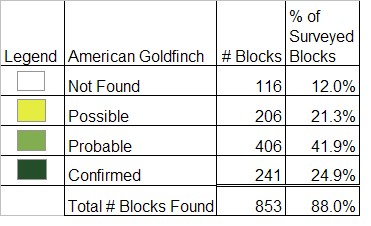Breeding Bird Atlases (BBA)
Find a Bird - BBA1
Breeding Bird Atlas 1 Species Accounts
American Goldfinch
Carduelis tristis
Egg Dates
July 10 to September 18
Number of Broods
one or two

The American Goldfinch is a welcome year-round resident throughout Massachusetts; this bird is one of our most colorful breeders in summer and a regular visitor to feeders in winter. During the Atlas period, nesting confirmations were made throughout the state. Goldfinches breed in areas that are generally rural in character, preferring overgrown fields and wood edges where there are shrubs and sapling trees. They also seem to favor areas that are wet, near lakes or in moist meadows and roadside ditches.
The breeding schedule of the American Goldfinch is very different from that of most of our other birds. Nesting activities occur in late summer, from July into September, when an abundant supply of favorite seeds has ripened. However, several interesting features of their behavior occur in spring as well. When the birds undergo their partial molt, from March to May, the male goldfinch attains his bright yellow plumage and begins singing, often in company with other males. These periods of song are interspersed with chases between males and between males and females. The song is a long series of canarylike chirps and trills. Some believe that this is indeed courtship behavior and that the pair bond is formed at this time, even though breeding does not usually take place for a month or more.
American Goldfinches have a variety of call notes. One of the most familiar is the per-chic-o-ree, frequently heard as the birds fly overhead. Another call is a pleasing chee-chee-chee-we series. There are also short chirps, and begging young give a chipee, chipee,…call.
Actual nesting territories are defended starting in late June. Males sing from exposed perches and chase off other males. They also do unusual circular flights over their territories. These are unusual in that the bird flies in a flat path rather than with the usual undulating flight seen at all other times of year. The birds do not restrict their movements to the territory and may move off it to feed. Once the female initiates nest building, the territory is no longer defended and other goldfinches may even land in the nest tree without being chased.
The female does all of the nest building. This activity has been observed in Massachusetts from July 1 to August 19 (CNR). The nest is usually built from 4 to 20 feet aboveground in the crotch of a sapling, shrub, or herbaceous plant and is composed of downy fibers, such as the filaments of various composite flowers, held together with sticky threads from Fall Webworm nests. Four Massachusetts nests were located in weedy or overgrown fields, and 1 was at the edge of a salt marsh. The nests were situated as follows: 1 each in goldenrod, willow, unidentified shrub, Box Elder, and Smooth Buckthorn. Heights ranged from 3 to 9 feet, with an average of 6.4 feet (CNR).
After nest building is completed, goldfinches often leave the nest for several days to two weeks before egg laying commences. An average clutch of five pale blue eggs is laid. Clutch sizes for 7 nests in Massachusetts were four eggs (3 nests) and five eggs (4 nests) (CNR, DKW). The female does all of the incubation, during which time the male feeds her by regurgitation. The eggs hatch in 12 to 14 days. For several days, the male feeds both his mate and young, but as the nestlings get older both parents feed them seeds that are partially digested and regurgitated from the crop.
The nestlings have light gray down on the head and body when they hatch, and for the first week they are quite silent. By 10 days they are well feathered and call noisily for food. As the young get older, the rim of the nest becomes covered with their droppings, an unusual situation among passerine birds. Nestlings remain in the nest for 11 to 15 days, after which they leave and are fed for several more weeks, usually by the male. At this time, the female may start building another nest for a second brood. Most pairs will renest if they lose their first set of eggs or young.
In Massachusetts, nestlings have been recorded from July 28 to September 28 (CNR), with one report from Essex County in early October (EHF). Brood sizes for 4 state nests were two young (1 nest), three young (1 nest), four young (2 nests) (CNR). Adults feeding fledglings have been observed in the Commonwealth from August 15 to September 28 (CNR).
After breeding is completed, both adult and young goldfinches undergo a molt, usually in late August and September. Migratory movement, especially of the young, begins in September and peaks in late October and early November. At this time, goldfinches gather into flocks varying from a few to more than a hundred. They often descend on areas where there is an abundance of small seeds, such as fields with fall- blooming composites or birch trees. In winter they are quiet except for their characteristic flight call. The wintering population of goldfinches is augmented by birds that nest farther north, and many of the goldfinches that nest in Massachusetts move south for the winter.
Map Legend and Data Summary
Atlas 1 data collected from 1975-1979


Note: common and widespread in shrubby fields, second-growth woodlands, and roadside edges
Donald W. Stokes and Lillian Q. Stokes



